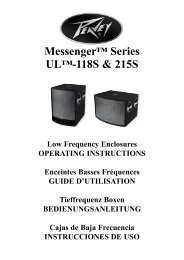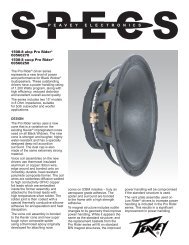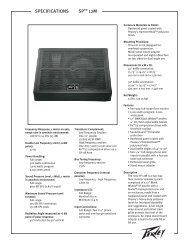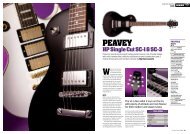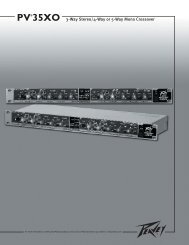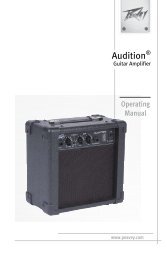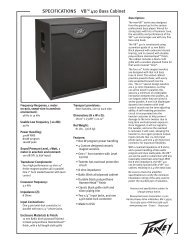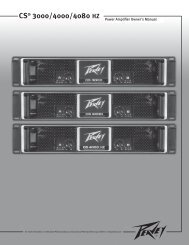Create successful ePaper yourself
Turn your PDF publications into a flip-book with our unique Google optimized e-Paper software.
F R O N T P A N E L<br />
Gain (1)<br />
This control establishes the nominal operating level for the channel. The input gain<br />
can be adjusted over a wide range to compensate for soft voices or very loud<br />
drums. To maximize the signal-to-noise ratio, the gain should be set to the proper<br />
level, with the channel level control (12) set to 0. If the clip LED comes on <strong>and</strong><br />
remains lit, try reducing the gain.<br />
80 Hz Low Cut (2)<br />
The low cut filter has a corner frequency of 80 Hz. When engaged‚ it can improve<br />
clarity by removing low frequencies that make a mix sound muddy. This feature is<br />
especially useful when playing outside on a windy day or on a hollow-sounding‚<br />
noisy stage. These kinds of ambient noises can rob your sound system of power.<br />
Engaging this switch will remove those frequencies from the system <strong>and</strong> restore<br />
power where needed.<br />
Hi EQ (3)<br />
An active tone control (shelving type: ±15 dB) that varies the level of the high<br />
frequency range.<br />
3<br />
4<br />
5<br />
6<br />
7<br />
8<br />
1<br />
2<br />
Mid EQ (4)<br />
An active tone control (peak dip: ±15 dB) that varies the mid frequency range.<br />
Low EQ (5)<br />
An active tone control (shelving type: ±15 dB) that varies the level of the low<br />
frequency range.<br />
Caution: Excessive low frequency boost causes greater power consumption <strong>and</strong> increases the<br />
possibility of speaker damage.<br />
MON Send (6)<br />
This control adjusts the level of the channel signal sent to the monitor output. The<br />
signal is taken before the channel level control but after the channel EQ.<br />
12<br />
<strong>10</strong><br />
11<br />
9<br />
EFX Send (7)<br />
This control adjusts the level of the channel signal added to the effects mix. The effects send signal is taken<br />
after the channel fader (12) so that adjustments made to the fader will also affect the send level.<br />
Pan (8)<br />
This knob controls the placement of the signal in the stereo field. When rotated completely counterclockwise‚<br />
the signal is present only on the left channel; when rotated completely clockwise‚ only in the right channel. On<br />
stereo channels 5/6 <strong>and</strong> 7/8 on the <strong>PV</strong> <strong>10</strong>, (11/12 <strong>and</strong> 13/14 on the <strong>PV</strong> 14), this control functions as a balance<br />
control to adjust the relative level of the left <strong>and</strong> right signals.<br />
Mute (9)<br />
The mute button is a quick way to remove the channel signal from the left/right main mix, effects <strong>and</strong> monitor<br />
sends without disturbing the control setting.<br />
Clip/Mute LED (<strong>10</strong>)<br />
This light normally indicates that the channel signal level is nearing the overload point, but it also lights when<br />
mute is engaged. The clip indicator circuit monitors the signal at many points in the channel to ensure that it<br />
catches all instances of clipping. It illuminates at +19 dBu <strong>and</strong> warns that the gain or EQ boost should be<br />
reduced. When it lights, roughly 3 dB of headroom remain.<br />
8




